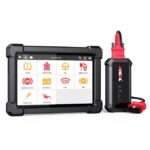OBD2 (On-Board Diagnostics II) ports offer a gateway to a vehicle’s engine data. But can you actually tune a car using just an OBD2 scanner or reader? While you can’t perform a full ECU remap through the OBD2 port alone, it plays a crucial role in the tuning process. Let’s explore the capabilities and limitations of OBD2 tuning.
Understanding OBD2’s Role in Tuning
The OBD2 port allows access to real-time engine data, including parameters like RPM, ignition timing, and various sensor readings (TPS, MAP, MAF, ECT, IAT, O2, VSS). This data is essential for understanding the engine’s performance and identifying potential issues. Devices like the Brockway R900/900e utilize this port to display vital engine information in an easy-to-understand format. The R900/900e can monitor:
- Engine RPM: Displays the engine’s current revolutions per minute.
- Ignition Timing: Shows the precise timing of the spark plugs.
- TPS (Throttle Position Sensor): Indicates the position of the throttle pedal.
- MAP (Manifold Absolute Pressure): Measures the pressure inside the intake manifold.
- MAF (Mass Air Flow): Measures the amount of air entering the engine.
- ECT (Engine Coolant Temperature): Monitors the engine’s operating temperature.
- IAT (Intake Air Temperature): Measures the temperature of the air entering the engine.
- O2 (Oxygen Sensor Voltage): Monitors the oxygen content in the exhaust gases.
- VSS (Vehicle Speed Sensor): Measures the vehicle’s speed.
OBD2 Tuning: Monitoring and Diagnostics
While a basic OBD2 scanner won’t directly modify the ECU’s settings, it provides valuable data that informs the tuning process. By monitoring sensor readings and identifying performance bottlenecks, tuners can make informed decisions about adjustments to fuel maps, ignition timing, and other parameters. Furthermore, the OBD2 port is crucial for reading, storing, and clearing Diagnostic Trouble Codes (DTCs), which pinpoint specific engine problems. This diagnostic capability helps tuners address underlying issues before making performance modifications. The Brockway R900/900e also offers features like a two-stage shift light and a 0-60 mph timer, utilizing an internal accelerometer for accurate measurements. These features, while not directly involved in tuning, contribute to performance analysis.
Beyond OBD2: Advanced Tuning Methods
For significant performance gains, a full ECU remap or reflash is necessary. This involves modifying the engine’s control unit software to alter parameters beyond what’s accessible through the OBD2 port. While some tuning solutions might utilize the OBD2 port for uploading the modified software, the actual tuning process goes deeper than simply reading and clearing codes. It requires specialized software and equipment to access and modify the ECU’s firmware.
Conclusion: OBD2 as a Tuning Tool
While you can’t tune a car solely with an OBD2 scanner, it serves as a vital tool for monitoring, diagnosing, and informing the tuning process. For basic adjustments and troubleshooting, an OBD2 scanner like the Brockway R900/900e offers a valuable window into your engine’s performance. However, for substantial tuning modifications, a full ECU remap by a professional tuner is necessary. The OBD2 port remains a critical component in both simple diagnostics and more complex tuning procedures.


